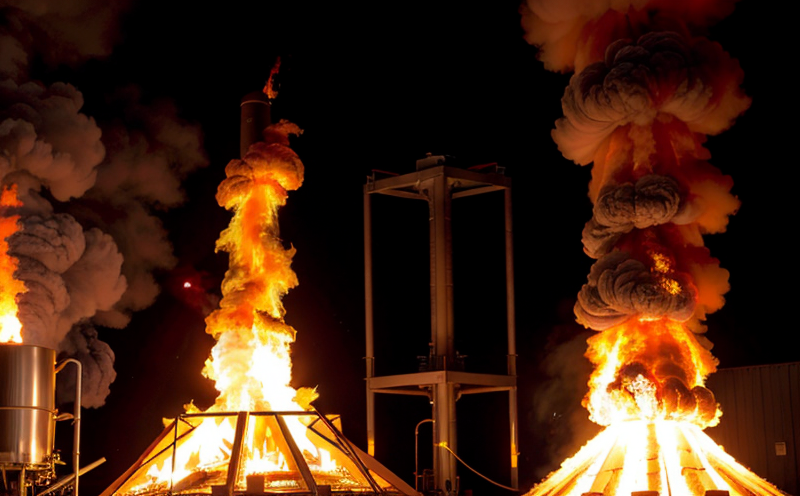JIS C60695 Flammability Testing of Electrical Components
The JIS C60695 standard is an essential tool in ensuring that electrical components are safe from fire hazards. This service focuses on the flammability testing of these components to meet stringent safety requirements as defined by this international standard.
Flammability tests are crucial for manufacturers and quality managers looking to ensure their products adhere to global standards, particularly within sectors like electronics, automotive, and consumer goods. By conducting JIS C60695 flammability testing, organizations can protect consumers from potential fire risks and comply with regulatory requirements.
The test aims to determine the ignition propensity of electrical components under specific environmental conditions. This includes evaluating how easily a component may ignite when exposed to sources such as sparks or flames. The procedure involves placing the specimen in an environment that simulates real-world usage, ensuring accurate results that reflect actual performance.
Compliance with JIS C60695 is not just about meeting regulatory requirements; it’s also about building trust and confidence among consumers and stakeholders. By demonstrating adherence to this standard, companies signal their commitment to product safety and quality assurance. This can translate into increased market share, improved brand reputation, and enhanced consumer satisfaction.
The testing process typically involves several stages, including preparation of the specimen, setting up the test apparatus according to JIS C60695 specifications, conducting the actual test, and analyzing the results. Each step is critical in ensuring accurate and reliable outcomes. For instance, proper sample preparation ensures that the material properties are representative of the final product.
The testing environment plays a vital role in obtaining consistent and repeatable results. This includes controlling temperature, humidity levels, and other environmental factors to mimic real-world conditions as closely as possible. The use of appropriate test apparatus further enhances the accuracy of the results by providing precise control over variables that can influence the outcome.
Once the testing is complete, the results are analyzed using standardized criteria set forth in JIS C60695. These criteria include specific measures such as time to ignition, flame height, and other parameters relevant to the type of component being tested. The analysis provides insights into the flammability characteristics of the specimen, helping manufacturers identify areas for improvement.
It’s important to note that JIS C60695 is not limited to just one method but encompasses various approaches depending on the nature of the electrical components. This flexibility allows for comprehensive evaluation across different types of products, ensuring a holistic approach to safety assessments.
In addition to meeting regulatory requirements, conducting flammability tests according to JIS C60695 can offer significant competitive advantages. By demonstrating compliance early in the product development cycle, companies can avoid costly recalls and reputational damage associated with non-compliance issues later on. Furthermore, adherence to this standard can open doors to new markets where stringent safety regulations are enforced.
For R&D engineers involved in developing innovative electrical components, JIS C60695 flammability testing serves as a crucial tool for validating design choices and ensuring that prototypes meet required safety standards before proceeding further. This early-stage validation can save time and resources by identifying potential flaws upfront rather than discovering them during later stages of production or after product launch.
Quality managers play a key role in overseeing the implementation of JIS C60695 testing within their organizations. They ensure that all relevant personnel are trained on proper specimen preparation techniques, test procedures, and interpretation of results. By maintaining strict adherence to these practices, they contribute significantly towards achieving consistent product quality across various production batches.
Procurement teams also benefit greatly from JIS C60695 flammability testing by being able to source components that meet the highest safety standards right from suppliers. This not only reduces risks associated with inferior materials but also helps in building long-term relationships based on mutual trust and reliability.
Environmental and Sustainability Contributions
- Reduces Fire Risks: By ensuring that electrical components do not pose a fire hazard, JIS C60695 flammability testing contributes significantly to environmental safety.
- Promotes Product Lifecycle Management: Ensuring safe operation throughout the product lifecycle helps minimize waste and extend useful life.
- Sustains Consumer Confidence: Compliance with rigorous standards like JIS C60695 fosters trust among consumers, which is crucial for sustainable business practices.
Competitive Advantage and Market Impact
Adhering to the stringent requirements of JIS C60695 provides a competitive edge by establishing your company as a leader in product safety. This not only enhances customer satisfaction but also opens up opportunities for exporting products globally, where such standards are mandatory.
From an operational perspective, compliance with these regulations ensures smooth supply chains and reduces the likelihood of delays due to non-compliance issues. It simplifies regulatory processes and streamlines interactions between different stakeholders involved in production and distribution.
The reputation gained from meeting international standards like JIS C60695 can significantly enhance brand value. Consumers are increasingly aware of sustainability practices, making it easier for compliant companies to attract eco-conscious customers who prefer brands that demonstrate responsibility towards both people and planet.
Use Cases and Application Examples
| Use Case/Example | Description |
|---|---|
| Automotive Industry: | Ensuring that electrical components used in vehicles meet strict flammability standards is crucial for preventing accidents caused by fires. |
| Electronics Manufacturing: | Evaluating the ignition resistance of circuit boards helps prevent malfunctions leading to potential hazards in consumer electronics. |
| Consumer Goods Production: | Testing the flammability properties of materials used in household appliances ensures safety for end-users. |
| Electrical Equipment Design: | Determining the ignition propensity during early design stages allows manufacturers to make necessary adjustments before mass production begins. |





